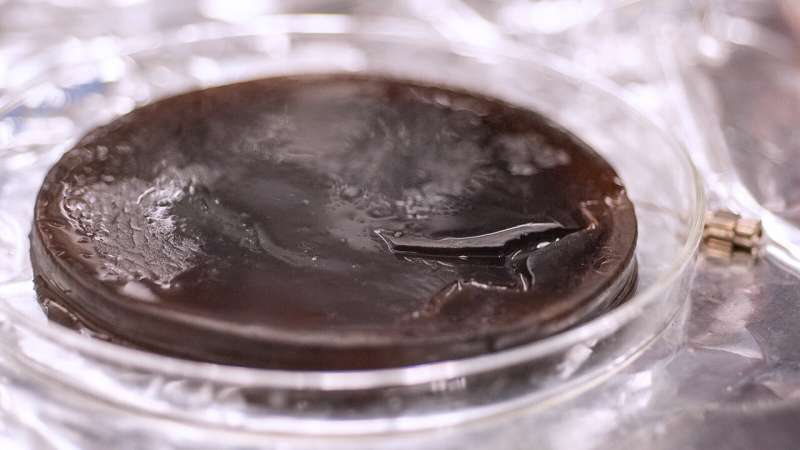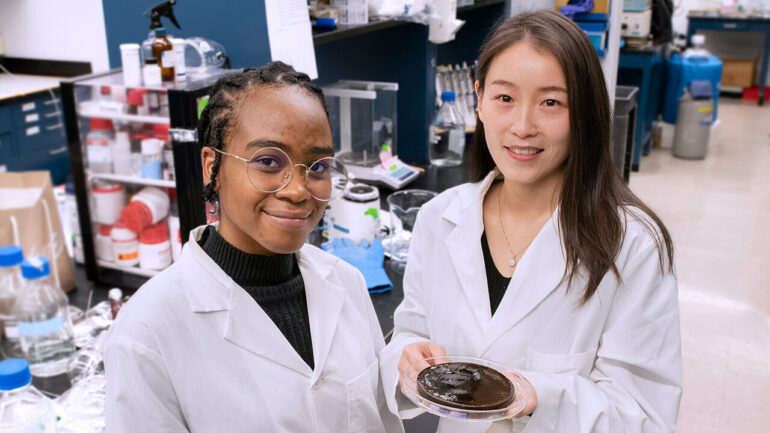Worldwide, over two billion people lack reliable access to clean water. And one potential solution for meeting that need works a lot like a sponge, soaking up clean water while leaving contaminants behind.
Researchers at Princeton University have developed the next generation of their solar absorber gel technology, a device that could be key to unlocking clean water access for people across the globe. The sponge-like gel is low-cost, easy-to-use, and requires only sunlight to filter pollutants such as heavy metals, oils, microplastics, and some bacteria from water, making it an alternative for off-grid water purification.
The device demonstrates an almost fourfold increase in filtration rate over the first-generation technology, which was developed in 2021. A square meter of the one-centimeter-thick material can produce over a gallon of water in as little as 10 minutes and could provide enough clean water to meet daily demand in many parts of the world. The details of the new solar absorber gel were published on Feb. 8 in ACS Central Science.
“There have been many efforts to develop a technology that uses solar energy to create clean, potable drinking water, but they often fail to produce enough water to meet daily need,” said Rodney Priestley, Dean of the Graduate School, Pomeroy and Betty Perry Smith Professor of Chemical and Biological Engineering, and associated faculty at the Andlinger Center for Energy and the Environment. “This latest iteration of our technology gets us another step closer towards the goal of having a technology driven by solar energy that can actually produce enough clean water to meet daily demand.”
At the core of the device’s sponge-like appearance is a gel formed from a polymer known as poly(N-isopropylacrylamide) or PNIPAm, which can either absorb or release water, depending on the temperature.
Below 33 degrees Celsius (91 degrees Fahrenheit), this hydrogel acts like a sponge to absorb water from a source such as a lake. But when the hydrogel is removed from the water and heated by sunlight to a temperature above 33 degrees, it begins to release the water. With the addition of polymers such as polydopamine (PDA) to the gel’s surface, the device can filter contaminants like oils, heavy metals, microplastics, and some types of bacteria from the water.
The researchers said the gel is less expensive and simpler to use than existing systems that rely on evaporation. Users simply toss the sponge-like device in a water source until it becomes saturated. Then they remove it from the water, place it in sunlight, and wait for it to release filtered water. Under the midday sun, the gel can release around 70% of the water it absorbs in as little as ten minutes.
“Our first solar absorber gel already had strong performance,” said Xiaohui Xu, a presidential postdoctoral fellow at Princeton University and the study’s first author. “But we wanted to continue making the device even more efficient at filtering water.”
According to Xu, the dramatic increase in filtration speed stems from changes the researchers made to the hydrogel’s structure between the first and second generations that enhanced its ability to transport water. While both the first and second generations utilize the same PNIPAm hydrogel, the researchers found they could change the gel to have a more interconnected, fibrous structure by synthesizing the polymer in a mixture of water and ethylene glycol.
Xu said the unconventional approach led to a key improvement over most existing hydrogels, which tend to have a honeycomb-like structure with walls that impede water transport. She compared the interconnected, fibrous structure of the new hydrogel to that of a mature loofah-fruit, which is commonly used as a scrubbing sponge in bathrooms and kitchens.

A sample of the solar absorber gel. © Bumper DeJesus/Princeton University
In addition to its enhanced filtration speed, Néhémie Guillomaitre, study co-author and a graduate student in chemical and biological engineering, added that the second-generation solar absorber gel sports other improvements over its predecessor.
For example, the researchers gave the solar absorber gel anti-fouling properties by adding another polymer, poly(sulfobetaine methacrylate) (PSBMA), to the surface of the gel. Not only does PSBMA help the device filter contaminants from water even more efficiently, but it also binds tightly with water molecules at the gel’s surface to form a hydration layer that repels oil and bacteria, which allows the device to be self-cleaning.
“Having anti-fouling properties helps the gel last longer,” Guillomaitre said. “There is less of a need to worry about oils and bacterial films accumulating on the gel’s surface over time and lowering its efficiency.”
The researchers ultimately believe the solar absorber gel could scale to become an attractive option for water purification at the household level and could provide access to clean water without needing to rely on energy from the grid.
“Ideally, this technology could one day be used by anyone concerned about their water quality, regardless of where they live,” Guillomaitre said.
While the researchers noted that they are still working to create prototypes to demonstrate their device can be scaled to household use, Priestley said in the near term, he believes the solar absorber gel could be used in emergency situations to provide on-demand access to clean water.
With support from the National Science Foundation, the research has led to the launch of a startup, AquaPao, co-founded by Priestley, which will continue to iterate and improve the design of the solar absorber gel, test its long-term durability, and identify opportunities to scale up the technology.
“This work is a wonderful example of how academic research can be translated into the startup world,” said Priestley. “Through our work, we have been able to show that fundamental research may have significant impact on society.”
The article, “Quick Release Anti-Fouling Hydrogels for Solar-Driven Water Purification,” was published in ACS Central Science on Feb. 8. In addition to Xu, Guillomaitre, and Priestley, authors include Kofi Christie, R. Kōnane Bay, Navid Bizmark, Sujit Datta, and Z. Jason Ren, of Princeton University.
More information:
Xiaohui Xu et al, Quick-Release Antifouling Hydrogels for Solar-Driven Water Purification, ACS Central Science (2023). DOI: 10.1021/acscentsci.2c01245
Provided by
Princeton University
Citation:
Solar-powered gel filters enough clean water to meet daily needs (2023, February 9)



